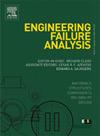Experimental study of fracture slip behavior in granite under different intermediate and minimum principal stresses
IF 4.4
2区 工程技术
Q1 ENGINEERING, MECHANICAL
引用次数: 0
Abstract
In deep rock engineering and deep resource exploitation, faults or fractures slip and reactivation usually leads to serious dynamic geological hazards (such as seismic activities, rock bursts and landslides). However, the effect of minimum principal stress (σ3) and intermediate principal stress (σ2) on rough fracture slip behavior remains enigmatic. Here we present an exploratory research on slip behavior of rough granite fractures under true triaxial (σ1 > σ2 > σ3) stress conditions. The results suggest that the peak strength for the fractured granite specimen increases with increasing σ3, but first increases and then decreases with increasing σ2. Increasing σ3 restricts the slip deformation, while increasing σ2 tends to first increase and then decrease the slip deformation. A three dimensional (3D) asperity which considers the contact, friction and matching relationship of fracture surfaces is used to account for the influence of σ3 and σ2 on strength and deformation behavior. The AE hits with larger amplitude tend to increase with increasing σ3 or σ2, indicating severer fault damage under higher stresses, which is consistent with the micro damage observed from SEM. The changes of wear regions and gouges with increasing σ3 or σ2 are in good agreement with that in peak strength and deformation along σ3. The decreasing b value and increasing strain along σ3 can be used as a precursor for fracture slip. Moreover, four strength criteria developed for intact rock were used to fit the results of the fractured rock, and the comparison shows that the Mogi-Coulomb criterion provides the most satisfactory results and can be used to predict the peak strength of fracture or fault failure in the applied stress regime. This study will provide new insight into a thorough understanding of shear behavior under different σ3 and σ2, and can also contribute to the stability assessment of fractured rock in deep underground engineering.
求助全文
约1分钟内获得全文
求助全文
来源期刊

Engineering Failure Analysis
工程技术-材料科学:表征与测试
CiteScore
7.70
自引率
20.00%
发文量
956
审稿时长
47 days
期刊介绍:
Engineering Failure Analysis publishes research papers describing the analysis of engineering failures and related studies.
Papers relating to the structure, properties and behaviour of engineering materials are encouraged, particularly those which also involve the detailed application of materials parameters to problems in engineering structures, components and design. In addition to the area of materials engineering, the interacting fields of mechanical, manufacturing, aeronautical, civil, chemical, corrosion and design engineering are considered relevant. Activity should be directed at analysing engineering failures and carrying out research to help reduce the incidences of failures and to extend the operating horizons of engineering materials.
Emphasis is placed on the mechanical properties of materials and their behaviour when influenced by structure, process and environment. Metallic, polymeric, ceramic and natural materials are all included and the application of these materials to real engineering situations should be emphasised. The use of a case-study based approach is also encouraged.
Engineering Failure Analysis provides essential reference material and critical feedback into the design process thereby contributing to the prevention of engineering failures in the future. All submissions will be subject to peer review from leading experts in the field.
 求助内容:
求助内容: 应助结果提醒方式:
应助结果提醒方式:


